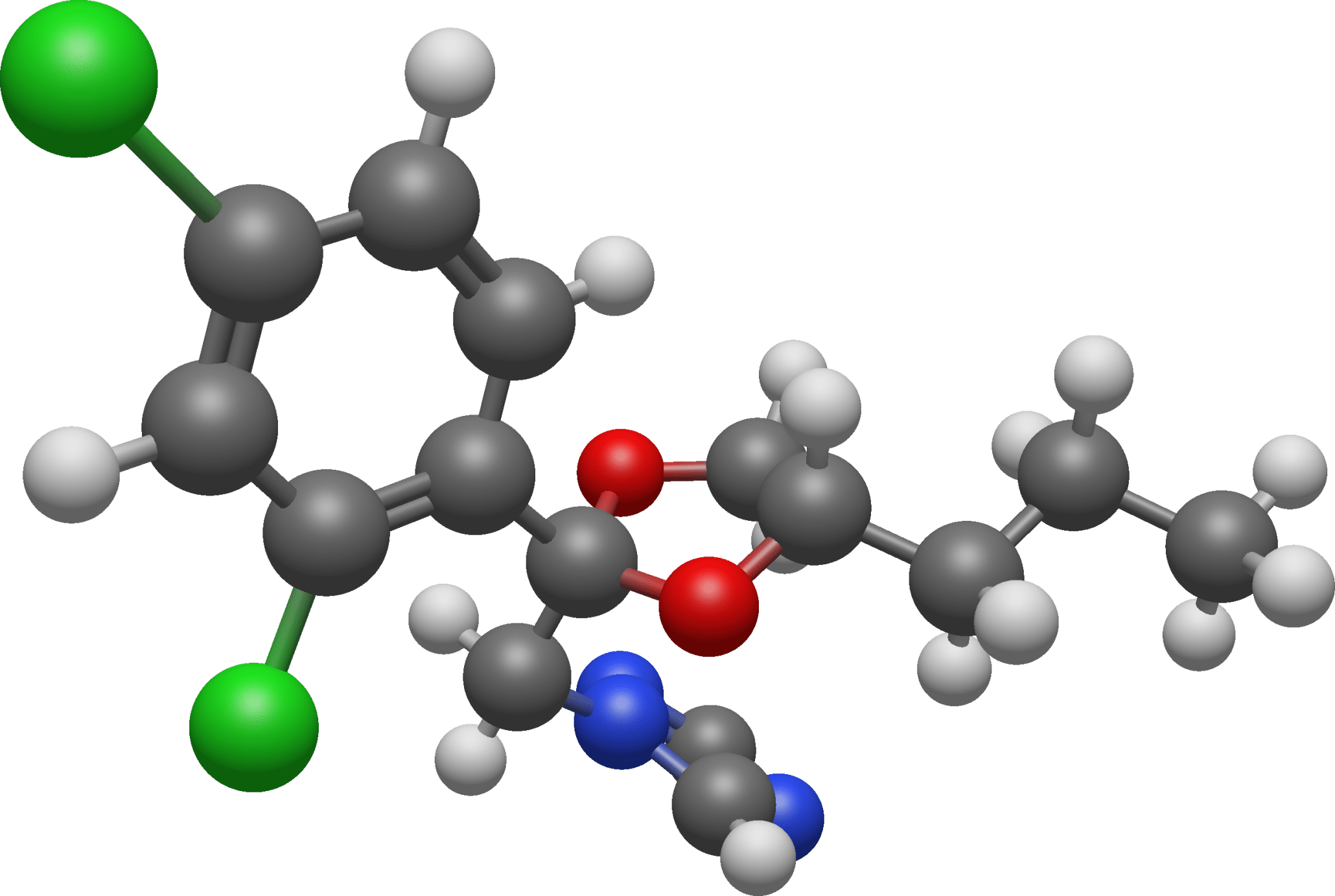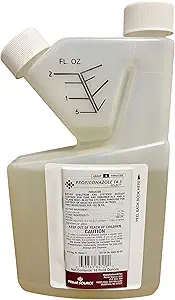Table of Contents
Introduction
Imagine the vast green fields, farmers diligently at work, and the golden crops swaying in the wind. An enchanting view, right? But lurking in the soil, in the air, and even on the leaves of plants are fungal pathogens, ready to strike. This is where propiconazole enters the scene, acting as a knight in shining armor for the crops. But before we delve deep into the world of propiconazole, let’s get a grip on the essence of fungicides in the realm of agriculture.
Understanding Fungicides
Fungicides are biocidal chemical compounds employed to impede the growth of fungi and fungal spores. Essential for agriculture, they play a pivotal role in safeguarding crops from potential diseases, ensuring the farmer’s hard work doesn’t go to waste and consumers get quality food on their plates.
Propiconazole – The Fungicidal Hero
Among the arsenal of fungicides, propiconazole stands out. Not just another fungicide in the market, propiconazole is a triazole fungicide, meaning it’s packed with properties that make it a potent weapon against a spectrum of fungal pathogens. Propiconazole as a fungicide isn’t just a contemporary find; it has a rich history and a track record of keeping crops healthy.
History and Development of Propiconazole
Delving into the past, propiconazole’s journey reads much like an adventure novel. From its discovery to its ascent as a premier fungicidal choice, every chapter of its tale holds an aura of wonder.
Discovery and Initial Applications
The story of propiconazole began in the laboratories during the late 20th century. Researchers, in their quest to find robust fungicides, stumbled upon the triazole group, a class of fungicides that exhibited immense potential. Among the myriad compounds, propiconazole emerged as a standout. Originally formulated to combat diseases in cereals, it rapidly proved its mettle.
Evolution in Usage Over the Years
With its efficiency showcased, propiconazole’s fame spread like wildfire. Initially limited to protecting cereals, its ambit soon widened. Farmers across continents began acknowledging its prowess. From fighting rust in wheat fields in the Americas to battling leaf spot diseases in Asian paddy fields, propiconazole started becoming the fungicidal mainstay.
Its usage wasn’t restricted merely to food crops. Turf managers in golf courses began employing propiconazole to ensure their greens remained lush and free from fungal threats. Nurseries and greenhouses, where conditions can often be conducive for fungal growth, adopted propiconazole as a measure to secure their floral treasures.
A Modern-day Marvel
Fast forward to the present day, and propiconazole is more than just a fungicide; it’s an agricultural staple. Its blend of efficacy and adaptability has rendered it a trusted ally for both small-scale farmers and large-scale agricultural operations. With advanced formulations and combinations now available, propiconazole’s journey from a lab discovery to a global sensation exemplifies innovation in agriculture.
Mechanism of Action
While many admire the magic of propiconazole in safeguarding crops, few take a deeper dive into its science. How does propiconazole function? How does it halt the insidious growth of fungi? Let’s embark on this microscopic voyage to decipher the magic behind propiconazole’s might.
The Cell – A Battlefield
Think of a fungal cell as a fortress. Each fortress has its defensive and offensive systems. One of the key systems fungi rely upon for growth is the synthesis of sterols, particularly ergosterol. It’s much like the fortified walls protecting a castle.
Targeting Ergosterol Synthesis
Enter propiconazole, the knight with a strategy. Instead of attacking the existing walls (ergosterol), propiconazole aims at the machinery that builds these walls. Specifically, it inhibits the enzyme lanosterol 14α-demethylase. This enzyme is crucial for fungi as it facilitates the conversion of lanosterol to ergosterol. With propiconazole in action, the synthesis of ergosterol is hindered.
But what happens when ergosterol synthesis is blocked? Imagine building a castle and running out of bricks midway. The structure becomes compromised, right? Similarly, the fungal cell membrane becomes compromised, leading to cell leakage and eventually, the death of the fungal cell.
Specificity – The Ace Up Propiconazole’s Sleeve
While the mechanism may sound like a broad-spectrum attack, propiconazole is quite a tactician. It’s choosy about its targets. The enzyme it inhibits is more prevalent in fungi than in plants. This means that while it goes all guns blazing against fungal pathogens, it remains largely benign to the crops it’s meant to protect. A win-win situation, isn’t it?
Conclusion of the Mechanism
In the world of crop protection, the mechanism of action isn’t just about killing pathogens. It’s about doing so while ensuring the crops remain unharmed. Propiconazole, with its precision-targeted action against fungal ergosterol synthesis, exemplifies this balance. It’s not just a fungicide; it’s a carefully crafted tool of plant protection.
Benefits of Using Propiconazole as a Fungicide
Propiconazole as a fungicide – even the name holds an air of promise, doesn’t it? As we’ve traversed its history and dissected its working mechanism, let’s pivot to perhaps the most intriguing aspect: its benefits. Why is propiconazole held in such high regard? Let’s illuminate this celebrated fungicide’s standout advantages.
Robust Protection Against a Wide Array of Pathogens
Some fungicides are like niche specialists, effective against a few specific fungal threats. Not propiconazole. Its versatility is its superpower. From rusts to powdery mildews, and from smuts to blights, propiconazole takes them head-on. This broad-spectrum efficacy ensures farmers don’t need a different fungicide for each potential threat, simplifying the protection strategy.
Long-Lasting Action
It’s not just about immediate protection; it’s about the duration. With many fungicides, recurrent applications become a norm due to their short-lived action. But propiconazole’s residual activity ensures that one application can offer protection for an extended period. This means fewer sprays, reduced labor, and ultimately, cost savings for farmers.
Compatibility and Versatility
Imagine having a potent weapon but facing restrictions on when or how to use it. Frustrating, right? Thankfully, propiconazole doesn’t come with such baggage. It’s compatible with many other agrochemicals, allowing farmers to mix and match as needed, optimizing their pest control regimens. Furthermore, its adaptability ensures efficacy irrespective of whether it’s used as a seed treatment, soil drench, or foliar application.
Enhanced Crop Yields and Quality
Fighting fungal diseases isn’t just about plant survival. It’s about ensuring that the crops flourish and provide maximal yields. Propiconazole doesn’t just prevent disease; it ensures that plants remain robust and healthy. The result? Enhanced yields and produce of superior quality. For a farmer, there’s no sight more rewarding than bountiful, healthy crops ready for harvest.
Environmental Friendliness
Protection shouldn’t come at the planet’s expense. Recognizing this, propiconazole has been designed to be eco-friendlier compared to many of its counterparts. Its lower application rates and reduced need for repeated sprays mean less chemical input into the environment. Plus, its targeted action against fungi ensures minimal impact on non-target beneficial organisms.
A Beacon of Reliability
In an age where fungal pathogens are continually evolving, having a fungicide that remains consistently effective is a boon. Propiconazole’s track record speaks volumes. Despite being in use for decades, it continues to be a beacon of reliability, warding off many pathogens that have grown resistant to other fungicides.
Conclusion of the Benefits
Unwrapping the benefits of propiconazole as a fungicide feels much like unearthing treasures, one after another. Its multifaceted advantages, from robust protection to environmental friendliness, render it not just a fungicide but a stalwart guardian of crops.
Potential Downsides and Concerns
Like the two sides of a coin, while propiconazole’s prowess in safeguarding crops is commendable, it’s crucial to delve into its potential downsides. No product, however advanced, is entirely free from drawbacks. So, let’s embark on a journey to uncover the concerns surrounding propiconazole and weigh them against its myriad benefits.
Toxicity Concerns
One of the primary concerns with any fungicide is its impact on human health. While propiconazole’s low dosage reduces the chances of direct harm, prolonged exposure can be a cause for concern. Studies have shown that it can act as an endocrine disruptor and might have potential carcinogenic effects. Therefore, ensuring that there is no residue in the food supply and taking proper precautions during application are paramount.
Environmental Persistence
Despite its eco-friendly label, propiconazole isn’t entirely devoid of environmental impact. The compound can linger in soils, with its half-life ranging from weeks to months. This persistence means that its residues might be taken up by subsequent crops, potentially entering the food chain. Moreover, in water bodies, propiconazole can impact aquatic life, particularly fish, at high concentrations.
Impact on Non-Target Organisms
While propiconazole’s specificity is a strength when fighting fungi, it can unintentionally affect non-target organisms. Beneficial fungi, which play a crucial role in soil health and plant growth, might suffer in areas treated heavily with propiconazole. This can, over time, affect soil fertility and disrupt the natural balance of microorganisms.
Resistance Development
Propiconazole has been a formidable foe to fungi for years. However, nature has a way of adapting. With recurrent use, there’s a risk of fungi developing resistance to propiconazole. Although this hasn’t been a widespread issue yet, the potential always exists. Integrated pest management, where propiconazole is one tool among many, can help mitigate this risk.
Economic Costs
From an economic standpoint, while propiconazole can lead to significant savings through increased yields and reduced application frequency, the initial investment might be high for some farmers, especially in developing countries. This can limit its accessibility and use.
Conclusion of the Downsides
Understanding the concerns surrounding propiconazole is essential for making informed choices. While its advantages are significant, these potential downsides remind us of the importance of judicious use, ongoing monitoring, and the quest for ever-safer alternatives in the realm of agriculture.
Comparison with Other Fungicides
In the grand tapestry of fungicides, where does propiconazole stand? By comparing propiconazole with other prevalent fungicides, we can paint a clearer picture of its strengths, weaknesses, and unique selling points. Strap in as we dive deep into the realm of fungi fighters.
Propiconazole vs. Chlorothalonil
Chlorothalonil, a broad-spectrum fungicide, has been a mainstay in the fight against fungi for decades. Unlike propiconazole, which specifically targets sterol biosynthesis in fungi, chlorothalonil disrupts various cellular processes. This means chlorothalonil often requires higher doses and frequent applications. However, its broad action can be an advantage in treating a wide range of fungi. Propiconazole, with its targeted action, is often more environmentally friendly and has a lower risk of residue in crops.
Propiconazole vs. Mancozeb
Mancozeb, a dithiocarbamate fungicide, acts by disrupting the lipid metabolism in fungi. It offers broad-spectrum control but, similar to chlorothalonil, needs frequent applications. Mancozeb is notorious for leaving residues, unlike propiconazole, which dissipates faster and has a lower residue risk. However, in terms of raw efficacy, mancozeb can often outshine propiconazole in controlling certain fungal species.
Propiconazole vs. Copper Fungicides
Copper fungicides are often organic farmers’ first choice. These fungicides, leveraging the natural antifungal properties of copper, have been in use for centuries. While they’re relatively safe and environment-friendly, they can sometimes be less effective against resilient fungal strains. Propiconazole, with its targeted action, often provides quicker and more lasting results, but it’s not always suitable for organic farming due to its synthetic nature.
Cost-Efficiency
On the financial front, propiconazole often strikes a balance. While its initial cost might be higher than some traditional fungicides, its long-lasting effects and reduced application frequency often make it a cost-effective choice in the long run. Farmers looking for an efficient solution that reduces labor and resource inputs might find propiconazole to be a worthy investment.
The Verdict
Propiconazole’s targeted action, environmental friendliness, and long-lasting effects make it a standout in the fungicide world. However, every fungus and crop scenario demands a unique approach. While propiconazole is a potent tool in the arsenal, it’s essential to consider the specific requirements, target fungi, and farming practices before making a choice.
Real-world Applications and Products
When it comes to application in real-world scenarios, propiconazole isn’t just a name on a list of chemicals. It’s a veritable superstar that has showcased its potency across various sectors. Let’s explore the vibrant landscape of its real-world applications and products where this fungicide hero shines the brightest.
Agricultural Marvel
Propiconazole’s primary and most noteworthy domain is agriculture. Farmers have seen a revolution in crop protection with its introduction. It’s used extensively to safeguard a myriad of crops, from the golden fields of wheat and barley to the lush orchards of fruits. The reduced frequency of applications means farmers can rest a little easier, knowing their crops are protected for longer from fungi’s relentless onslaught.
Lawn and Garden Care
Those perfectly manicured lawns and blooming gardens aren’t just a result of dedicated gardening. Behind the scenes, propiconazole plays a pivotal role in keeping the menacing fungi at bay. Many commercial lawn care products boast of propiconazole as a key ingredient, ensuring that those greens stay pristine and those flowers bloom unmarred.
Timber Protection
It’s not just the living plants that benefit. Timber, often vulnerable to wood decay fungi, gets a protective shield with propiconazole. Its application ensures that wood structures, whether they be a part of homes or furniture, have an extended life and remain safe from the clutches of destructive fungi.
Popular Products in the Market
Several products in the market have recognized the prowess of propiconazole and have incorporated it. Brands like “Banner Maxx” and “Tilt” are household names in many farming communities. They offer easy-to-use solutions combining propiconazole’s strength with other ingredients for a comprehensive protective cover against a spectrum of threats.
Supporting Sustainable Agriculture
Given the increasing emphasis on sustainable farming practices, propiconazole’s role becomes even more crucial. Its targeted action means less overall chemical use, its long-lasting effect implies reduced tractor runs, and its high efficacy results in better yields. In essence, it supports the pillars of sustainable agriculture, making farming both productive and environment-friendly.
Final Thoughts on Applications
From vast fields to the wooden deck in your backyard, propiconazole’s influence is wide-reaching. Its versatility and efficacy have cemented its position in the world of fungicides. As research continues and newer applications emerge, this fungicide’s footprint in real-world applications is only set to grow.
Conclusion
The journey of propiconazole, from its nascent stages of development to its robust real-world applications, is nothing short of a testament to human ingenuity and the relentless pursuit of agricultural advancement. As we navigate this evolving landscape of crop protection and sustainable farming, the importance of such potent fungicides becomes ever more apparent.
The Balancing Act
It’s essential to recognize that like all tools, the true value of propiconazole lies in its judicious use. While its benefits in protecting crops, preserving timber, and enhancing yields are undeniable, it’s equally important to be aware of its potential downsides. A balanced approach ensures that we reap its benefits while minimizing any adverse effects.
Looking Ahead
The world of agriculture is in a constant state of flux, adapting to new challenges and leveraging innovative solutions. As fungi evolve and develop resistance, the onus is on research and development to stay a step ahead. The story of propiconazole is not just a chronicle of past achievements but also a beacon of what’s possible in the future. With continued research, we can anticipate even more refined and effective versions of this fungicide, catering to the ever-changing needs of agriculture.
Embracing Sustainable Practices
As the emphasis on sustainable and environment-friendly farming grows, the role of fungicides like propiconazole will be under the scanner. It’s not just about combating fungi but doing so in a manner that is harmonious with nature. The comprehensive protection that propiconazole offers, combined with its support for sustainable practices, places it in a unique position to be a frontrunner in this endeavor.
Final Words
In summation, propiconazole stands as a remarkable innovation in the realm of fungicides. Its multifaceted benefits, combined with a keen understanding of its limitations, make it an invaluable asset for modern agriculture. As we tread the path of food security and sustainable farming, propiconazole will undoubtedly be a trusted companion in that journey.



